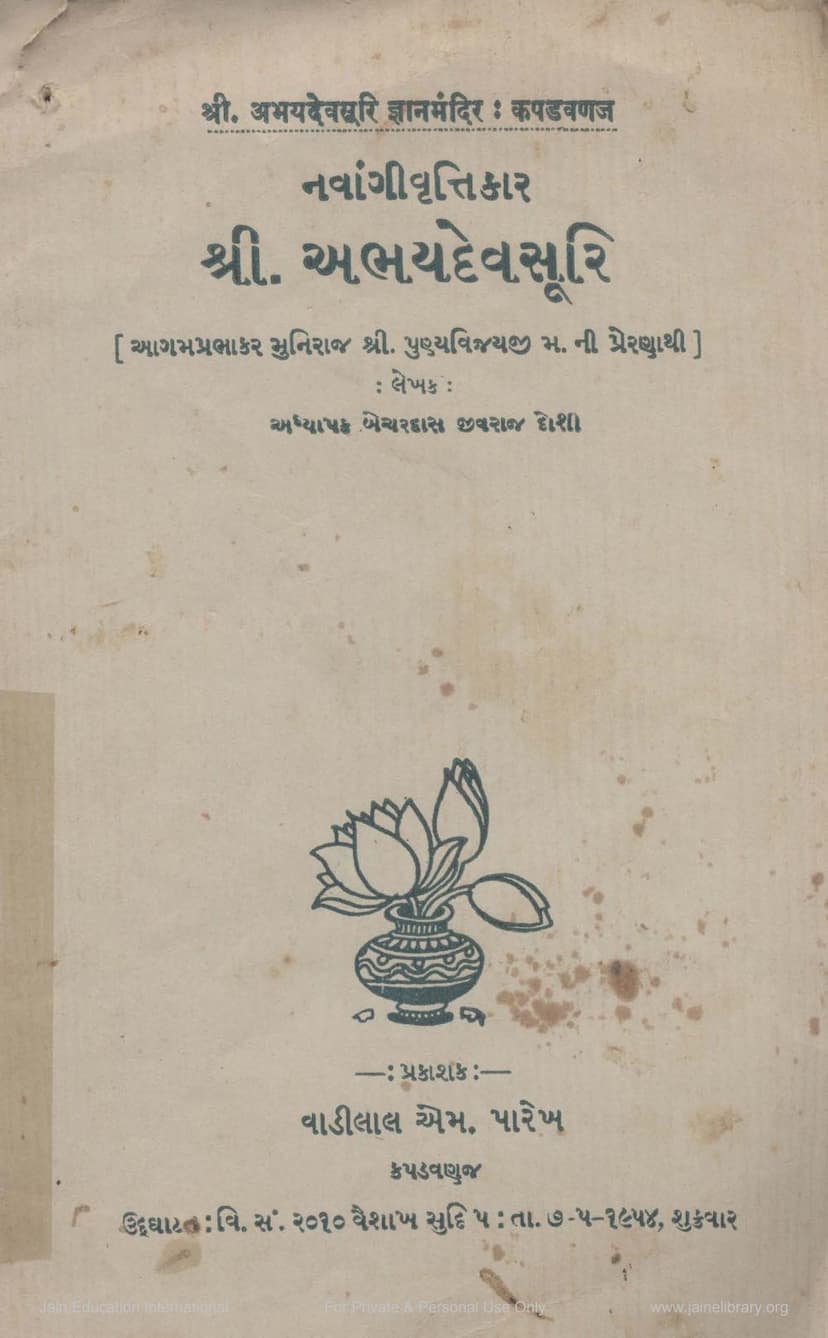Navangivruttikar Abaydevsuri
Added to library: September 2, 2025

Summary
Here's a comprehensive summary of the Jain text provided, focusing on the life and work of Acharya Abhaydevsuri:
Book Title: Navangivruttikar Abaydevsuri Author: Bechardas Doshi Publisher: Vadilal M Parekh Kapadwanj Catalog Link: https://jainqq.org/explore/004868/1
This book, published in 1954, is dedicated to the esteemed Jain Acharya Abhaydevsuri, renowned for his commentaries on the Angas (sacred Jain texts). It highlights his significant contributions to the preservation and propagation of Jain scriptures, particularly during a period of decline and disarray in the Jain tradition.
The book emphasizes the concept of "bhidbhanjan" (one who breaks through difficult situations) in Jainism, citing examples like Acharya Siddhasen Divakar who dispelled blind faith, and Acharya Haribhadra who restored virtuous conduct. It then places Acharya Abhaydevsuri in this lineage of saviors.
Key Contributions and Life of Acharya Abhaydevsuri:
- Preservation of Jain Agamas: The central theme is Abhaydevsuri's monumental effort to save the Jain Agamas when they were fragmented, in disarray, and becoming difficult to understand. He collected various recensions (readings), standardized them, and painstakingly compiled them, creating commentaries (vruttis) to ensure their survival and accessibility.
- Addressing Scriptural Decay: The text details the critical state of Jain scriptures during Abhaydevsuri's time. The tradition of studying and meditating on the Agamas had weakened, with a focus shifting to storytelling, devotional songs, and entertainment. The Agamas themselves were in poor condition, with errors, variations in readings, and conflicting interpretations.
- Historical Context: The book delves into the historical background of the decline in scriptural study. It points to the rise of Chaityavasi (monastics residing in temples and enjoying temple property) traditions from around the 5th century CE, which led to a laxity in ascetic practices, indulgence, and a departure from the core principles of Jain renunciation. This contrasted with the earlier tradition of Nirgranthas who practiced severe austerity in solitary places.
- Personal Life and Circumstances:
- Limited Biographical Details: The author notes the scarcity of precise biographical information about Abhaydevsuri's birth, parents, and early life, with most accounts stemming from later texts like Prabhavak Charitra (written about two centuries after his time).
- Illness and Healing: Abhaydevsuri suffered from a severe illness (described variously as blood disorder, leprosy, or other ailments). During this time, he faced accusations from some that his illness was a divine punishment for errors in his commentaries. He sought solace and healing by establishing a new shrine dedicated to Bhagwan Parshvanath at Thambhana. It is believed that his devotion and the establishment of this new pilgrimage site led to his recovery.
- Disciple of Jineshwara Suri: Abhaydevsuri received initiation from Jineshwara Suri and later Acharya Pad. He was highly learned, mastering both Jain and Vedic traditions.
- Timeline: His commentaries on the Angas were primarily written between 1120 and 1128 CE. He wrote extensively while residing in Patan, with some works composed in Dholka.
- Place of Nirvana: While some traditions suggest his demise in Kapadvanj (where his footprints are preserved), the Prabhavak Charitra clearly states his Nirvana occurred in Patan during the reign of King Bhima.
- Collaborations and Support:
- Dronacharya and the Chaityavasis: Despite the general decline, there were learned and devout individuals like Dronacharya, a respected Chaityavasi Acharya, and his group. Abhaydevsuri sought their support and collaboration to validate his commentaries. Dronacharya and his followers meticulously reviewed and endorsed Abhaydevsuri's works, demonstrating great magnanimity and a commitment to the preservation of knowledge, even across different monastic traditions. This collaboration was crucial for the acceptance and authenticity of Abhaydevsuri's commentaries.
- The Importance of Study and Research: The book highlights the immense effort Abhaydevsuri invested in comparing various readings, correcting errors, and providing clear explanations. This involved significant personal sacrifice, long hours of study, and overcoming considerable obstacles.
- Nature of his Commentaries: His commentaries are described as lucid, easily understandable, and written in clear language, effectively explaining the meaning of the sutras without unnecessary elaboration or excessive argumentation. He carefully selected readings, compared different versions, and sometimes acknowledged differing interpretations from earlier commentators.
- Humility and Devotion: Despite his profound scholarship and arduous work, Abhaydevsuri maintained remarkable humility, attributing his work to the grace of his gurus and seeking feedback from scholars to identify and correct any mistakes. His writings consistently reflected his deep devotion to the Jain tradition and a selfless commitment to its preservation.
- The Significance of Kapadvanj: The book also highlights the religious significance of Kapadvanj, the location of the "Shri Abhaydevsuri Gyanmandir" institution. It mentions that Kapadvanj has a long history of Jain devotion, with historical records indicating religious fervor and patronage from its residents in ancient times. The establishment of the Gyanmandir in Kapadvanj is seen as a continuation of this tradition, aiming to spread knowledge and benefit the community.
Publisher's Statement:
The publisher, Vadilal M. Parekh, shares his personal motivation for supporting the establishment of the Gyanmandir. He expresses a deep desire for self-improvement and spiritual knowledge, recognizing the need for a strong educational institution to guide the youth. He recounts his intention to establish a "Pathshala" (school) and a "Gyanmandir" (knowledge temple) and his decision to name it after Acharya Abhaydevsuri, inspired by his profound scholarship and the historical connection of the Acharya to Kapadvanj. He sees this as a way to bring spiritual merit to himself and the community.
Conclusion:
In essence, the book "Navangivruttikar Abaydevsuri" is a tribute to a pivotal figure in Jain history. It not only chronicles the life and extraordinary dedication of Acharya Abhaydevsuri in preserving the Jain Agamas through his extensive commentaries but also provides valuable historical context regarding the challenges faced by Jainism during his era. His work is presented as a testament to scholarship, resilience, and unwavering devotion to the Jain faith.